When it comes to culinary creativity, some of the most memorable dishes are born from daring combinations. Savory Meets Sweet: The Ultimate Crab Brûlée Recipe is one of those rare gems that pushes boundaries and delivers something truly unique. Inspired by the elegance of French cuisine and the boldness of modern fusion cooking, this dish reimagines the classic crème brûlée—not as a dessert, but as a show-stopping appetizer or sophisticated small plate.
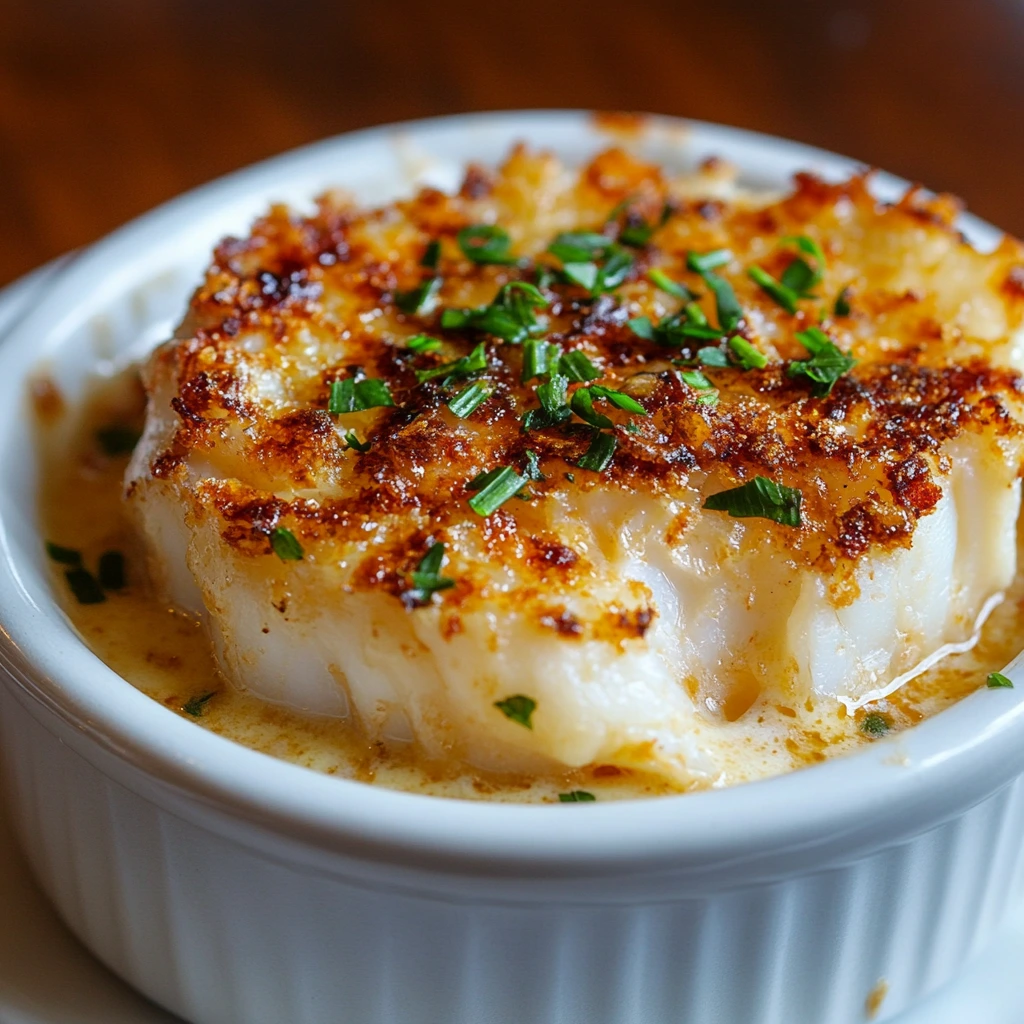
Savory Meets Sweet: Why Crab Brûlée Works
Crab Brûlée may sound like an unexpected fusion at first, but the contrast between savory and sweet flavors is what makes this dish so compelling. The key to its success lies in how both elements—crab and caramelized sugar—complement each other while offering distinct, but harmonious, experiences for the palate. Here’s why this savory-sweet combination works so wonderfully:
- Sweetness Enhances the Natural Flavors of Crab:
Crab meat, with its delicate sweetness, provides a perfect base for the custard. When paired with the hint of sugar from the brûlée crust, it elevates the crab’s subtle, sweet undertones. The natural brininess of the crab also plays well with the sweetness of the caramelized sugar, creating a balanced flavor profile that surprises and delights the taste buds. Instead of overpowering the crab, the sweetness draws out its natural flavors, making each bite rich and memorable. - The Richness of Savory Custard:
The creamy, savory custard base adds depth to the dish. Made with egg yolks, cream, and seasonings, the custard introduces a luxurious, velvety texture that contrasts beautifully with the crispy brûlée top. This rich texture also serves as a perfect counterpart to the lightness of the crab, providing a satisfying mouthfeel. The savory components of the custard—such as herbs, a pinch of salt, and perhaps even a touch of mustard or garlic—further enhance the umami notes of the crab. - Contrast in Textures:
The brilliance of the crab brûlée lies in the interplay of textures. The delicate crab meat remains tender and slightly firm, while the custard is smooth and creamy. The pièce de résistance, however, is the brûlée crust. The crackling sugar top, once torched to perfection, provides a satisfying crunch that contrasts sharply with the smooth custard beneath it. This mix of textures—soft, creamy, tender, and crunchy—creates a dynamic and exciting eating experience. - Unexpected Pairing That Intrigues the Palate:
One of the most exciting aspects of crab brûlée is its ability to surprise. People expect crème brûlée to be a sweet dessert, but with crab and savory custard as the base, it’s a flavor profile that plays with expectations. This unexpected combination captures the imagination of the eater, turning a familiar dish into something entirely new and intriguing. It’s a conversation starter and a great way to show how a little culinary creativity can open up entirely new avenues of flavor. - Cultural and Culinary Fusion:
The pairing of savory and sweet isn’t entirely new in the culinary world. From sweet-and-sour sauces to bacon paired with caramel, chefs have long understood how these seemingly opposing flavors can coexist and even complement each other. Crab Brûlée takes inspiration from this tradition, blending classic French technique with modern culinary curiosity. The result is a dish that feels both sophisticated and innovative.
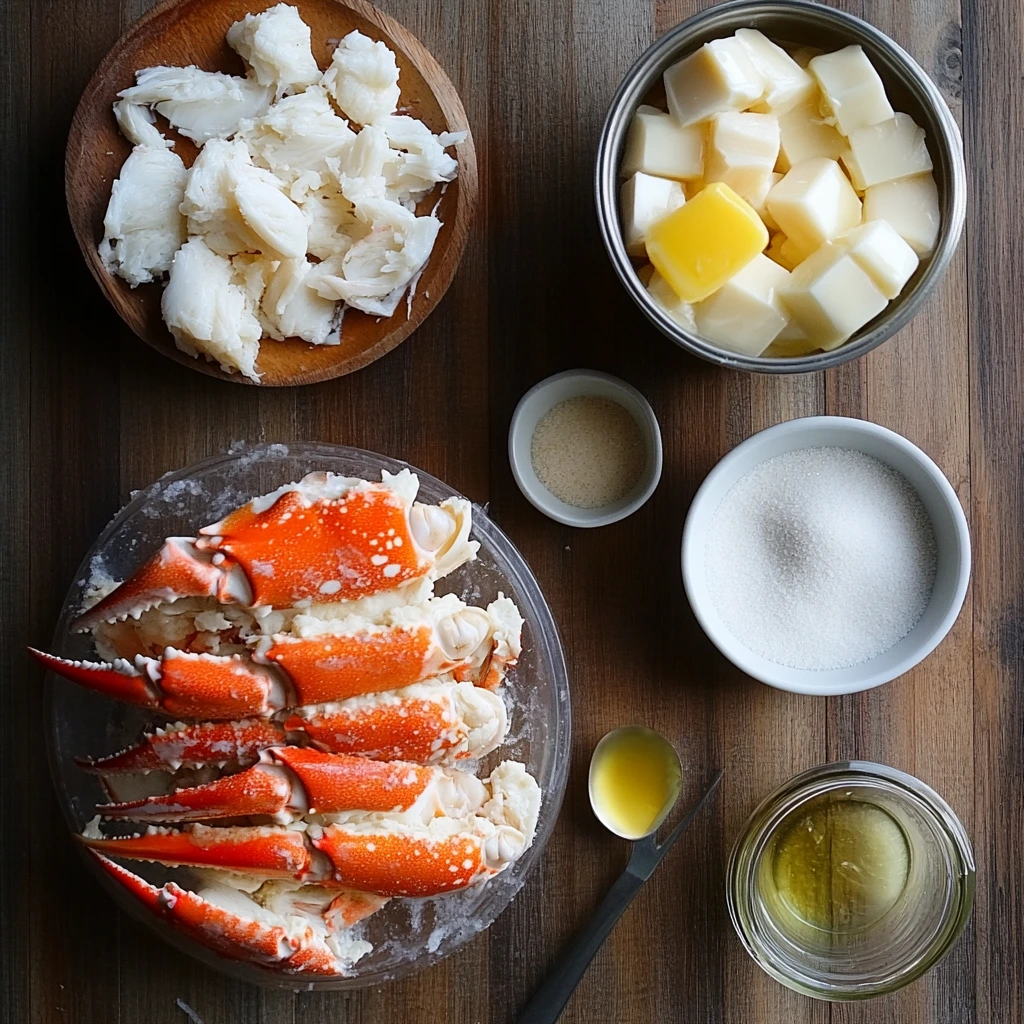
Ingredients That Make It Exceptional
Crab Brûlée isn’t just a visually stunning dish—it’s an exceptional flavor experience that relies on the quality and combination of its ingredients. Each element, from the delicate crab meat to the rich custard and the sugary topping, plays a crucial role in crafting a dish that is both luxurious and memorable. Let’s break down the key ingredients that make this dish truly stand out:
- Fresh Crab Meat:
The star of this dish is, of course, the crab. Fresh crab meat—whether it’s lump, claw, or a combination—provides a natural sweetness and delicate texture that forms the heart of the dish. Freshness is key here: the meat should be sweet, tender, and flavorful, with a subtle oceanic brininess that enhances the savory notes of the custard. Whether you use crab from a can or fresh-picked, the quality of the crab is paramount. It’s worth sourcing the best you can find, as the sweet, tender meat is what gives the crab brûlée its signature flavor. If you’re looking for a more sustainable or affordable option, you can also use crab alternatives like imitation crab or langoustine. - Heavy Cream:
The custard base relies heavily on the richness of heavy cream. The fat content of cream creates a smooth, velvety texture that is essential to the custard’s consistency. The cream forms the luxurious base that complements the crab’s delicate flavor and gives the brûlée its signature mouthfeel. When paired with egg yolks, it helps to create that perfect, silky consistency, so each bite is satisfying without being overly heavy. For a slightly lighter option, you can substitute half-and-half or milk, but the richness of heavy cream is what makes this dish indulgent. - Egg Yolks:
Egg yolks are the essential thickening agent in the custard. They help bind the cream and other ingredients together, creating that smooth, creamy consistency that’s so desirable in a brûlée. Beyond texture, egg yolks also bring a subtle richness and color to the custard, enriching the flavor profile without being overpowering. They work together with the cream to provide the perfect balance of fat and flavor, making each bite feel luxurious. - Herbs and Seasonings:
While crab and cream are the main stars, the seasoning is what elevates the dish to the next level. Fresh herbs like tarragon, chives, or parsley can add an aromatic layer that complements the delicate sweetness of the crab. A hint of garlic, shallots, or even a dash of Dijon mustard can infuse savory depth into the custard. Salt and pepper balance the sweetness of the crab and the richness of the cream, ensuring that the flavors are well-rounded. A pinch of cayenne or chili flakes can also be added to introduce a subtle heat, creating a more complex flavor profile that contrasts beautifully with the sweetness of the brûlée. - Sugar for the Brûlée Crust:
The signature element of any crème brûlée is the crispy, caramelized sugar top. This sugar layer is more than just decoration—it adds texture and plays a crucial role in balancing the savory and sweet components of the dish. When caramelized, the sugar creates a satisfying crack that contrasts with the soft, smooth custard beneath. It also introduces a delightful sweetness that enhances the natural sweetness of the crab, adding a finishing touch that completes the flavor profile. It’s important to use a high-quality sugar—typically granulated white sugar—to ensure the perfect caramelization. - Vanilla Bean or Vanilla Extract (Optional):
Some variations of crab brûlée include a hint of vanilla in the custard. The warm, aromatic flavor of vanilla can be a nice addition, rounding out the sweetness of the crab and the sugar. Vanilla beans can be scraped directly into the custard, or you can use a good-quality vanilla extract. However, this is optional—if you prefer a more straightforward savory flavor, you can skip the vanilla and focus purely on the crab and savory custard.
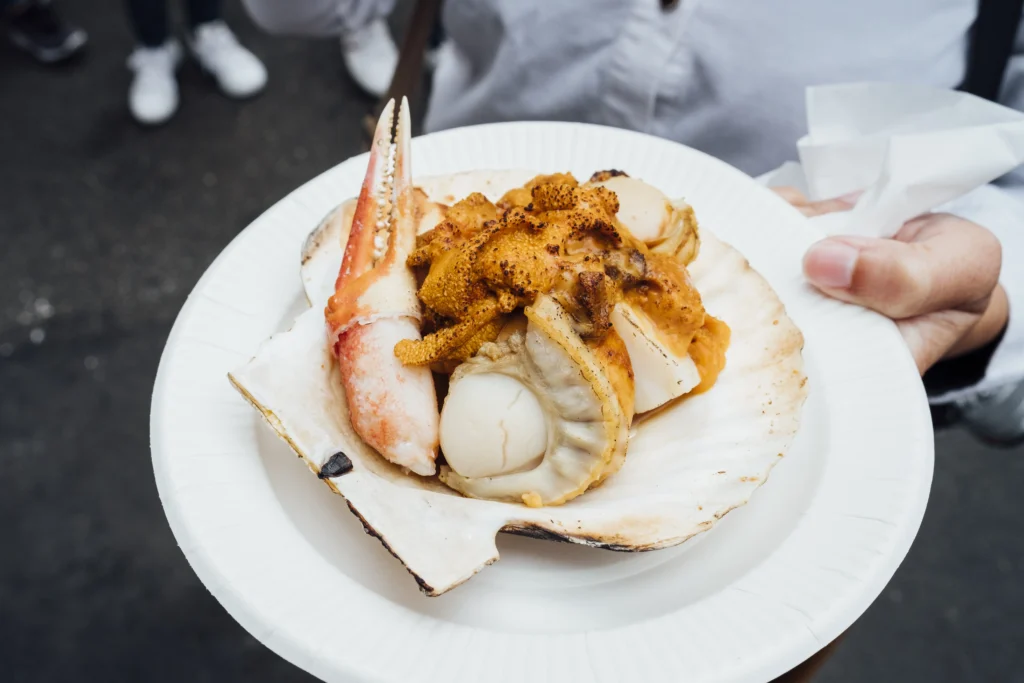
Step-by-Step: How to Make Crab Brûlée
Making Crab Brûlée is a simple yet sophisticated process, and it’s all about layering flavors and textures to create a dish that’s both luxurious and balanced. With a little time and patience, you can craft this elegant appetizer right at home. Follow these steps to make a perfect Crab Brûlée:
1. Prepare the Crab Meat and Custard Base
Before anything else, ensure your crab meat is fresh and ready to go. If you’re using fresh crab, carefully pick through the meat to remove any shells or cartilage. If you’re using canned or frozen crab, drain and gently pat it dry.
- Season the Crab: In a small bowl, gently toss the crab meat with a pinch of salt, pepper, and a dash of your favorite herbs (such as tarragon or chives). Set this aside so it can absorb the flavors while you prepare the custard.
- Make the Custard: In a medium saucepan, heat the heavy cream over low heat until it’s just warm—not boiling. This step will help the cream infuse any aromatics or spices you may want to add, such as garlic, shallots, or a bay leaf (optional).
- Whisk the Eggs: In a separate bowl, whisk the egg yolks with a pinch of salt and pepper. Slowly stream in the warm cream while continuously whisking to temper the eggs. This prevents them from curdling. Once combined, return the mixture to the saucepan and cook over low heat until it thickens enough to coat the back of a spoon, about 5–7 minutes.
2. Combine Crab Meat and Custard
- Layer the Crab: Gently fold the seasoned crab meat into the custard mixture. Be careful not to break up the delicate crab pieces too much. The goal is to have it evenly distributed throughout the custard, so each bite of the brûlée gets a little crab in every spoonful.
- Fill Ramekins: Pour the crab-custard mixture into individual ramekins, leaving a little room at the top for the sugar crust. Smooth out the surface of each ramekin with the back of a spoon for an even layer.
3. Bake the Crab Brûlée
- Set Up a Water Bath: Preheat your oven to 325°F (163°C). Place the ramekins in a large baking dish or roasting pan. Carefully pour hot water into the pan, coming halfway up the sides of the ramekins. This water bath helps cook the custard evenly and gently, ensuring a smooth texture without curdling.
- Bake the Custard: Place the pan in the oven and bake for about 25–30 minutes, or until the custard is set but still slightly jiggly in the center. You can test this by gently tapping the side of the ramekin. Once done, remove the ramekins from the water bath and let them cool to room temperature before refrigerating for at least 2 hours to allow the flavors to meld.
4. Caramelize the Sugar Crust
- Add the Sugar: Once the crab brûlées have chilled and set, it’s time to add the signature caramelized sugar topping. Sprinkle a thin, even layer of granulated sugar over the top of each ramekin. Be careful not to use too much sugar, as it can burn during the caramelization process.
- Torch the Sugar: Using a kitchen torch, caramelize the sugar by moving the flame in small circles above the sugar until it turns golden brown and starts to bubble slightly. If you don’t have a kitchen torch, you can also broil the brûlées in the oven for a couple of minutes—just be sure to keep a close eye on them to prevent burning.
5. Serve and Enjoy
Once the sugar is perfectly caramelized and the brûlée has cooled for a few minutes, your Crab Brûlée is ready to serve. Garnish with fresh herbs like parsley or chives, or even a little squeeze of lemon for extra brightness. Serve the dish immediately while the sugar crust is still crisp.
Pro Tips
- Don’t Overcook the Custard: The key to a silky custard is gentle heat. Avoid overheating the cream and egg mixture to prevent it from curdling.
- Use a High-Quality Crab: The better the crab, the better your brûlée will taste. Fresh crab meat is ideal, but you can substitute with high-quality canned crab if necessary.
- Allow for Chilling Time: The custard needs time to fully set and develop its flavors. Don’t rush this step, as it makes all the difference in texture.
- Torching Tips: If you’re using a kitchen torch, make sure to hold the flame about 2 inches from the surface and keep it moving to achieve an even caramelization.
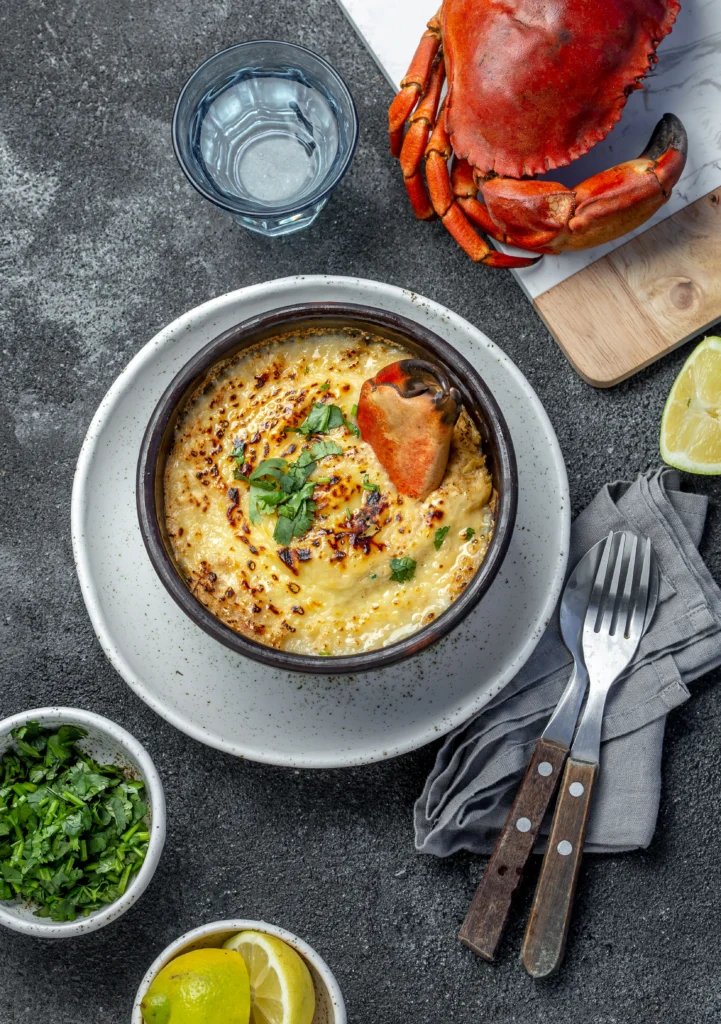
Serving Suggestions & Pairings
Crab Brûlée is an elegant dish that can easily take center stage at any dinner party or special occasion. Its rich, savory-sweet flavor profile makes it a versatile option that pairs wonderfully with a variety of sides, drinks, and garnishes. Here are some serving suggestions and pairing ideas to elevate your Crab Brûlée experience:
1. Side Dishes to Complement the Richness
While Crab Brûlée is the star of the show, pairing it with the right side dishes can elevate the entire meal and provide a balance of flavors and textures. Consider light, refreshing sides to cut through the richness of the custard.
- Crisp Green Salad: A simple mixed greens salad with a light vinaigrette or citrus dressing provides a refreshing contrast to the richness of the crab. The acidity in the dressing helps cleanse the palate between bites of the creamy, savory brûlée.
- Roasted Vegetables: Roasted asparagus, baby carrots, or Brussels sprouts with a drizzle of olive oil and a squeeze of lemon are perfect companions. The slight bitterness of the roasted vegetables complements the sweetness of the crab and sugar topping, adding depth to the meal.
- Grilled or Steamed Asparagus: The slight bitterness of grilled or steamed asparagus makes it an ideal side dish for the sweet and savory crab brûlée. A sprinkle of parmesan cheese or a drizzle of hollandaise sauce could elevate the dish even further.
- Buttery Mashed Potatoes or Cauliflower Purée: For a heartier side, mashed potatoes or cauliflower purée add a comforting, smooth texture that complements the creamy custard in the crab brûlée. Add a hint of garlic or truffle oil to elevate these sides.
2. Garnishes to Enhance the Flavor
Garnishes are the finishing touches that can take your Crab Brûlée from delicious to extraordinary. Here are some ideas to elevate the presentation and add a burst of fresh flavor:
- Fresh Herbs: Garnish with finely chopped herbs like chives, tarragon, or parsley. These herbs add a pop of color and a burst of freshness that helps balance the richness of the dish. Herbs like dill or basil could also provide interesting flavor contrasts.
- Lemon Zest or Lemon Wedges: A small sprinkle of lemon zest or a fresh lemon wedge on the side provides a zesty note that contrasts nicely with the sweetness of the brûlée. The citrus brightness cuts through the richness and adds a refreshing touch.
- Microgreens or Edible Flowers: For a touch of elegance, garnish the crab brûlée with delicate microgreens like arugula or baby spinach. Edible flowers like pansies or nasturtiums can also make the dish visually stunning while contributing subtle peppery notes.
- Caviar or Roe: For an extra luxurious touch, consider topping the crab brûlée with a small dollop of caviar or roe. This adds a briny, salty contrast to the sweetness of the sugar crust and works beautifully with the crab.
3. Beverage Pairings
The right drink can enhance the flavors of the crab brûlée and provide a refreshing contrast to the dish’s richness. Whether you prefer wine, cocktails, or non-alcoholic options, there are several beverages that pair wonderfully with this dish.
- White Wine: A crisp, chilled white wine is an excellent choice to pair with crab. Look for a wine with good acidity and a slight minerality to cut through the richness of the custard. A classic choice would be a Chardonnay (preferably unoaked for a fresher feel), or a Sauvignon Blanc, which has bright acidity and citrusy notes that complement the crab’s sweetness. Pinot Grigio or Albariño are also excellent options.
- Champagne or Sparkling Wine: The effervescence of champagne or sparkling wine provides a refreshing contrast to the creamy texture of the crab brûlée. Choose a dry, brut champagne to keep the focus on the flavors of the dish without overwhelming it with sweetness.
- Light, Citrusy Cocktails: Cocktails with citrusy or herbal notes work well with Crab Brûlée. A Gin and Tonic with a splash of lime or a Cucumber Mint Mojito would provide refreshing herbal elements that balance the richness of the dish. A Classic Daiquiri (rum, lime, and sugar) could also pair nicely, offering a refreshing and tangy contrast.
- Non-Alcoholic Options: For non-alcoholic pairings, consider serving sparkling water with a twist of lemon or lime for a refreshing palate cleanser. A cold-pressed cucumber or citrus juice could also add a refreshing, slightly savory note that complements the dish.
4. How to Serve Crab Brûlée
Crab Brûlée can be served in individual ramekins, making it easy to present as an elegant appetizer or main course. Here are a few tips on how to present and serve it:
- Individual Ramekins: Serving Crab Brûlée in individual ramekins allows each guest to enjoy their own portion. These small, elegant containers also help create a refined atmosphere at the table.
- Temperature Consideration: Crab Brûlée is best served slightly warm, allowing the custard to be creamy and the sugar crust to remain crisp. If you’re preparing it ahead of time, chill it in the refrigerator and torch the sugar crust just before serving to achieve the perfect contrast of temperatures.
- Elegant Table Setting: To complete the fine dining experience, serve Crab Brûlée with fine china or crystal stemware. A well-set table with polished utensils and a fresh flower centerpiece adds an extra touch of sophistication for a truly memorable meal.
Tips, Tricks & Custom Variations
Crab Brûlée is a delicious and sophisticated dish, but it’s also versatile and open to personal twists. Whether you’re looking to customize the recipe to your taste or improve the technique, these tips, tricks, and variations will help you perfect your Crab Brûlée every time. From adding bold flavors to perfecting the texture, here’s everything you need to know:
1. Tips for Perfecting the Technique
- Don’t Overcook the Custard: One of the most important aspects of making crab brûlée is achieving the perfect custard consistency. It should be silky and smooth, not curdled or scrambled. To avoid overcooking, cook the custard over low heat and keep stirring constantly when adding the warm cream to the egg yolks. Test for doneness by dipping the back of a spoon into the custard—the mixture should coat the spoon and form a thin, silky layer.
- Use a Water Bath: The water bath is key to evenly cooking the custard. This gentle cooking method ensures that the heat is distributed evenly, preventing the custard from curdling. When setting up your water bath, make sure the water reaches halfway up the sides of your ramekins but doesn’t spill into the custard.
- Cool Before Caramelizing the Sugar: After baking the crab brûlée, let the ramekins cool to room temperature and refrigerate them for at least 2 hours before adding the sugar topping. Chilling allows the custard to set fully, making it easier to achieve that perfect, crisp sugar top when you use the torch or broiler.
- Torching Technique: When caramelizing the sugar, use a kitchen torch and keep the flame about 2–3 inches above the sugar. Move the flame in small circular motions for an even caramelization. If using a broiler, place the ramekins under the broiler for about 1–2 minutes but keep a close eye on them to prevent burning.
2. Custom Variations to Try
While the traditional Crab Brûlée recipe is exquisite, there are numerous ways to customize it to suit your preferences or add a personal touch. Here are some variations to try:
- Lobster Brûlée: For a luxurious twist, replace the crab with fresh lobster meat. Lobster adds a slightly sweeter and richer flavor that pairs beautifully with the creamy custard and the caramelized sugar topping. You can also combine lobster and crab for a more indulgent seafood experience.
- Smoked Crab Brûlée: If you’re a fan of smoky flavors, try using smoked crab meat or adding a dash of liquid smoke to the custard base. The smoky undertones will create an intriguing contrast with the sweetness of the sugar crust and complement the oceanic flavors of the crab.
- Spicy Crab Brûlée: For those who enjoy a little heat, incorporate a touch of cayenne pepper or finely chopped fresh chili into the custard mixture. The spiciness will balance out the sweetness of the sugar crust and give your Crab Brûlée a bold, unexpected flavor.
- Herb-Infused Crab Brûlée: Experiment with different herbs to infuse the custard. Tarragon, basil, thyme, or even dill can provide unique flavor profiles that complement the sweetness of the crab. To infuse, add the herbs to the cream as it heats, then strain them out before combining with the egg yolks.
- Citrus Crab Brûlée: Adding a touch of citrus zest, like lemon or orange, can brighten the flavors of the crab and custard. A bit of lemon juice or zest in the custard can bring a refreshing, tangy contrast to the richness of the dish, while orange zest can add a subtle sweetness that pairs beautifully with crab.
- Vegetarian Option: If you want to make a vegetarian version, you can substitute the crab with roasted or sautéed mushrooms, particularly varieties like chanterelle or shiitake, which have a meaty texture. A combination of finely chopped mushrooms and a few tablespoons of vegetable stock will add earthy flavors that mimic the richness of crab.
3. Tricks to Elevate the Dish
- Use High-Quality Crab: The quality of the crab meat will significantly impact the overall flavor of the dish. Fresh, sweet crab meat is essential for the best result, so whenever possible, use freshly picked crab. If using canned or frozen crab, look for premium options for the most natural and fresh flavor.
- Balance the Sweetness: The sugar topping is sweet, but you don’t want it to overwhelm the delicate flavor of the crab. Aim for a thin, even layer of sugar—just enough to provide that perfect crack when you torch it. If you’re concerned about it being too sweet, you can also try using a little brown sugar for a deeper, more caramel-like flavor.
- Experiment with Flavored Custards: While the classic custard is rich and smooth, you can infuse additional flavors to personalize it further. Add a hint of Dijon mustard for a tangy twist, or use a splash of dry white wine like Chardonnay for a more complex, savory undertone.
- Incorporate an Element of Texture: For an interesting texture contrast, consider adding crispy breadcrumbs or fried shallots on top of the crab mixture before baking. This adds a little crunch and depth to each bite, balancing the creamy custard and the sweet sugar crust.
- Make It a Multi-Layered Dish: If you’re feeling adventurous, you can try layering crab with other ingredients in between the custard layers. Thinly sliced vegetables like zucchini or leeks can add freshness, or you can add a small amount of seasoned rice or quinoa for a more substantial version of Crab Brûlée.
4. Make Ahead and Storage Tips
If you’re preparing Crab Brûlée for a special occasion, making it ahead of time is possible with just a few considerations:
- Prep in Advance: You can prepare the custard and crab mixture the day before, then bake the ramekins and refrigerate overnight. Be sure to allow the brûlées to chill for at least 2 hours before adding the sugar crust and caramelizing it.
- Store Leftovers: If you have leftovers, store them in the refrigerator, covered with plastic wrap. It’s best to remove the sugar crust if storing leftovers, as it will lose its crispiness when refrigerated. To reheat, simply warm the custard in a low oven and add a fresh sugar topping before serving.
- Freezing: While not ideal for the sugar crust, you can freeze the crab brûlée custard base before baking. Once baked and chilled, the custard will store well in the freezer for up to a month. Just make sure to wrap the ramekins tightly in plastic wrap and foil.
Table of Contents
Vegan Pesto Recipe Without Pine Nuts – Light, Fresh & Flavorful – labelrecipes.com
Easy Crab Brulee Recipe: A 100% Savory French Classic (freshrecipes.net)

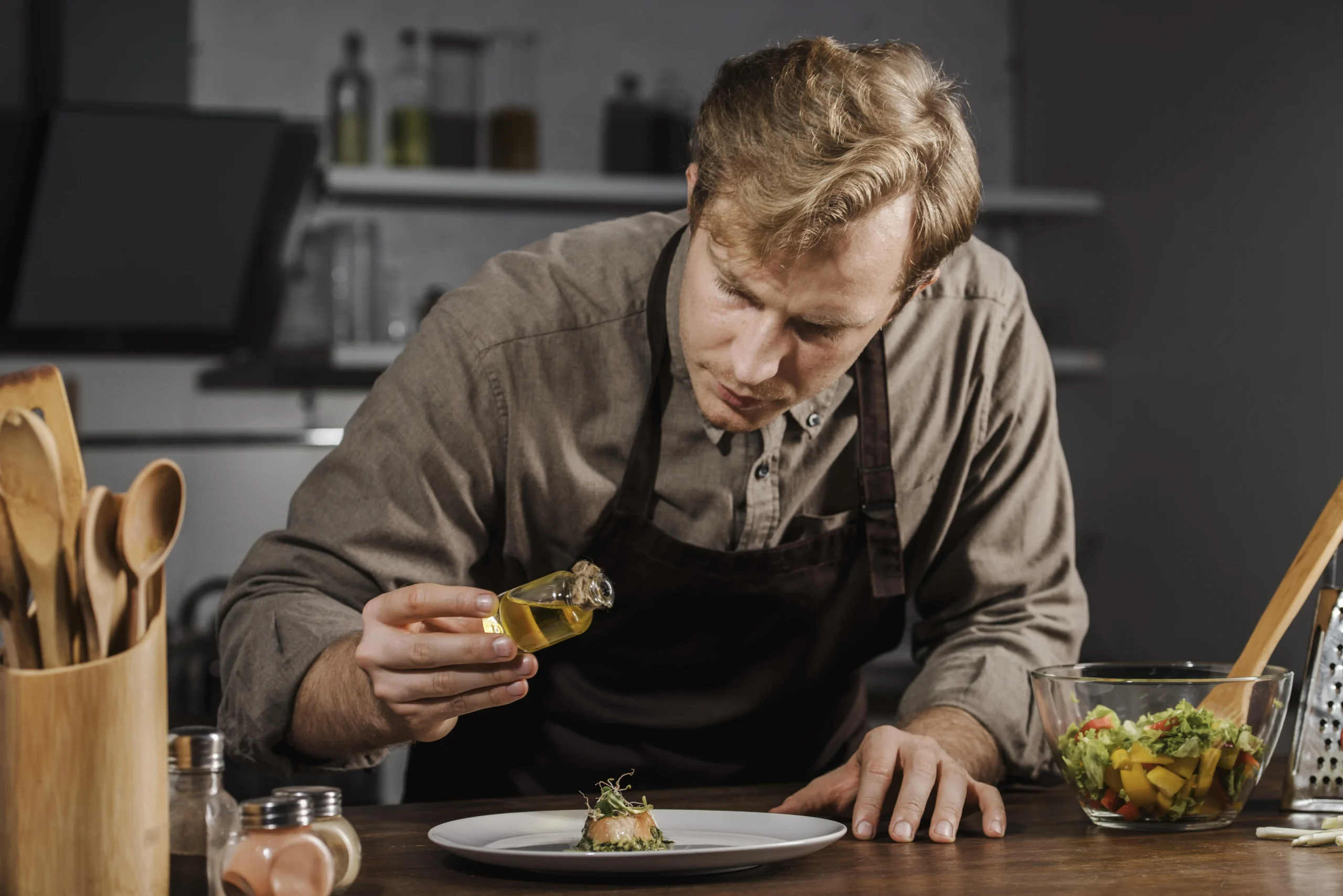
Awesome https://lc.cx/xjXBQT
thank you so much